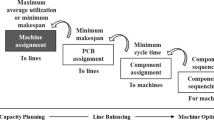Abstract
This research considers the problem of minimizing the total amount of energy consumption in inner layer scrubbing process in printed circuit board (PCB) manufacturing. The degree of adhesion between interlayers in multilayer circuit board (MCB) manufacturing is the most critical factor in reliability of products. Generally, the inner layer scrubbing process is the process that removes certain debris such as oxide or fingerprints occurring on surface of tin core (inner materials or inner circuit board). Also, this process makes the surface of copper rough in order to stick liquid photo resist (LPR) and dry film well by enhancing the adhesion. In order to promote the adhesion, the formal way is to use brushes or oxide chemical by making the surface of copper rough. Through these ways, we can minimize the heat shock and defective adhesion. So, in this research, heuristic approaches are applied to inner layer scrubbing process in order to find the optimal operating conditions of the process which minimize the total amount of energy consumption while keeping the required quality, that is, roughness in a certain prespecified range. The model for describing the roughness behavior in inner layer scrubbing process is constructed by using categorical regression analysis. And then, the performance of the heuristic method is investigated and compared to that of a random search approach. Numerical results reveal that the genetic algorithm provides moderately good performance with respect to the measure of minimizing the total amount of energy consumption in inner layer scrubbing process as well as the computation time.
Similar content being viewed by others
Abbreviations
- x 1 :
-
Brush type
- x 2 :
-
Brush RPM
- x 3 :
-
Brush pressure
- x 4 :
-
Conveyor speed
- y :
-
roughness
References
Jeswiet, J. and Kara, S., “Carbon emissions and CESTM in manufacturing,” CIRP Annals — Manuf. Technology, Vol. 57, No. 1, pp. 17–20, 2008.
Liow, J. L., “Mechanical micromachining: a sustainable microdevice manufacturing approach?” J. Cleaner Prod., Vol. 17, No. 7, pp. 662–667, 2009.
Luo, Z., Cheng, K., Holt, R., and Liu, Z., “Modeling flank wear of carbide tool insert in metal cutting,” Wear, Vol. 259, No. 7–12, pp. 1235–1240, 2005.
Rajemi, M. F., Mativenga, P. T., and Aramcharoen, A., “Sustainable machining: selection of optimum turning conditions based on minimum energy considerations,” J. Cleaner Prod., Vol. 18, No. 10, pp. 1059–1065, 2010.
Pusavec, F., Krajnik, P., and Kopac, J., “Transitioning to sustainable production — Part I: application on machining technologies,” J. Cleaner Prod., Vol. 18, No. 2, pp. 174–184, 2010.
Ancu, M., “The Optimization of Printed Circuit Board Manufacturing by Improving the Drilling Process Productivity,” Computers and Industrial Eng., Vol. 55, No. 2, pp. 279–294, 2008.
Shi, X., Schillings, P., and Boyd, D., “Applying Artificial Neural Networks and Virtual Experimental Design to Quality Improvement of Two Industrial Processes,” Int. J. Prod. Res., Vol. 42, No. 1, pp. 101–118, 2004.
Shi, H., Song, F., and Fu, L., “Experimental study on drilling force in printed circuit board micro drilling process,” Circuit World, Vol. 37, No. 1, pp. 24–29, 2011.
Watanabe, H., Tsuzaka, H., and Masuda, M., “Microdrilling for printed circuit boards (PCBs) — influence of radial run-out of microdrills on hole quality,” Precis. Eng., Vol. 32, No. 4, pp. 329–335, 2008.
Tahir, Z., Abu, N. A., Sahib, S., and Herman, N. S., “CNC PCB Drilling Machine using Novel Natural Approach to Euclidean TSP,” Computer Science and Information Technology (ICCSIT), 2010 3rd IEEE International Conference, pp. 481–485, 2010.
Hsieh, J., Chang, P., and Hsu, L., “Scheduling of drilling operations in printed circuit board factory,” Computers & Industrial Engineering, Vol. 44, No. 3, pp. 461–473, 2003.
Singh, G. K., Yadava, V., and Kumar, R., “Diamond face grinding of WC-Co composite with spark assistance: Experimental study and parameter optimization,” Int. J. Precis. Eng. Manuf., Vol. 11, No. 4, pp. 509–518, 2010.
Montgomery, D. C., Peck, E. A., and Vining, G. G., “Introduction to Linear Regression Analysis,” John Wiley & Sons, pp. 265–287, 2001.
Kirkpatrick, S., Gelatt, C. D., and Vecchi, M. P., “Optimization by Simulated Annealing,” Science, Vol. 220, No. 4598, pp. 671–680, 1983.
Černý, V., “Thermodynamical approach to the traveling salesman problem: An efficient simulation algorithm,” J. Optimization Theory and Applications, Vol. 45, No. 1, pp. 41–51, 1985.
Metropolis, N., Rosenbluth, A. W., Rosenbluth, M. N., Teller, A. H., and Teller, E., “Equation of State Calculations by Fast Computing Machines,” The J. Chemical Physics, Vol. 21, No. 6, pp. 1087–1092, 1953.
Granville, V., Krivanek, M., and Rasson, J. P., “Simulated annealing: A proof of convergence,” IEEE Transactions on Pattern Analysis and Machine Intelligence, Vol. 16, No. 6, pp. 652–656, 1994.
Goldberg, D. E., “Genetic Algorithms in Search, Optimization and Machine Learning,” Addison-Wesley Longman Publishing, 1989.
Hillier, F. S. and Lieberman, G. J., “Introduction to Operations Research,” McGraw-Hill, pp. 644–653, 2005.
Author information
Authors and Affiliations
Corresponding author
Rights and permissions
About this article
Cite this article
Park, YJ., Lee, GB. Application of heuristic approaches to minimization of energy consumption in inner layer scrubbing process in PCB manufacturing. Int. J. Precis. Eng. Manuf. 13, 1059–1066 (2012). https://doi.org/10.1007/s12541-012-0138-8
Received:
Accepted:
Published:
Issue Date:
DOI: https://doi.org/10.1007/s12541-012-0138-8



